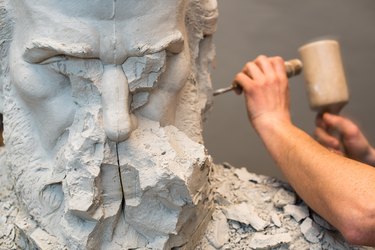
Plaster of Paris is created from fine ground gypsum that has been heated to 160 degrees, a process called calcining. The heating process removes moisture from the gypsum, altering its chemistry and creating a fine powder. When mixed with water it can be manipulated in many ways, from sculptures to modeling, but a basic plaster of Paris mixture is hard but fragile when dry. Strengthening it with glue creates a strong plaster that withstands the test of time.
Basic Plaster and Glue Recipe
Video of the Day
This basic plaster and glue recipe is for small plaster casting projects. The mixture makes a hard plaster of Paris that's durable enough to be sanded with fine grit sandpaper. You can use the same recipe as a foundation for larger projects by scaling up the batch, as long as you make sure to keep the ingredient ratios the same.
Video of the Day
Things You'll Need
Newsprint or old newspapers
8-ounce measuring cup
1/4-cup measuring cup
Plastic mixing bowl
Water
White glue
Wooden spoon
Plaster
Face mask
Gloves
Mixing Strong Plaster
Step 1: Prepare the Work Area
Cover you work area with a layer of newsprint to prevent the plaster from sticking to important surfaces.
Step 2: Mix Water and Glue
Place 1 1/4-cup water in a plastic mixing bowl. Add 1/4-cup white glue to the water. Mix the water and glue until the glue is thoroughly incorporated into the water. The water should appear milky and have a creamy consistency.
Step 3: Add the Plaster
Slowly pour 2 cups of plaster of Paris into the water. Add a small amount of plaster at a time. Sprinkle the plaster evenly across the surface of the water and glue mixture. Allow the plaster to settle to the bottom, and do not stir. Stirring at this point may cause excessive air bubbles that will weaken the plaster. Continue to add plaster of Paris until you've used all 2 cups.
Step 4: Rest and Mix
Let the plaster rest for about five minutes before mixing. Use the plaster mixture immediately.
Tip
Using more plaster in your plaster mix creates harder denser molds. Using less plaster creates more porous and brittle molds.
Wear a face mask if the fine dust from Plaster of Paris affects you. Wear vinyl gloves to protect your hands.
Adjusting Drying Times
- Speed up the drying time by adding a small amount of pure gypsum to the mix.
- Add a couple of drops of lemon juice to slow the drying time.
- Use warm water to speed up the setting time.
Clean Up Hard Plaster
Cleaning as you go makes the process that much easier. Wash mixing utensils and bowls with warm water and soap. Never pour leftover plaster of Paris down the drain. This can clog pipes and become a costly mistake once it hardens. If plaster hardens on a surface, carefully break or chip the hardened plaster and clean the area with soap and water.
Warning
Mixing plaster of Paris with water causes an exothermic (heat-producing) reaction. Never place plaster of Paris onto skin. It can cause serious burns. If it gets onto your skin wipe the wet plaster away with a dry paper towel and clean the area with a wet paper towel and soap.
- Mc Silicone: How to Make Extra Strong Plaster of Paris for Casting
- How To Build Realistic Model Railroad Scenery
- Justamorph United Artworks: The Plaster Faq: Working With Plaster
- Ceramic Arts Daily: Plaster Mixing 101: How to Mix Plaster for Ceramic Molds
- Henrick Norsker and James Danisch: Forming Techniques for the Self Reliant Potter